You Can't Have Too Much Backup
There are lots of online backup services and I strongly recommend using one of them (Carbonite is my favorite) but I really don't like to lose important files such as photographs, client's files, and tax records. A disk failure, just like a collision at sea, can ruin your whole day. So in addition to Carbonite, I maintain a local hot backup and a nearby system backup.
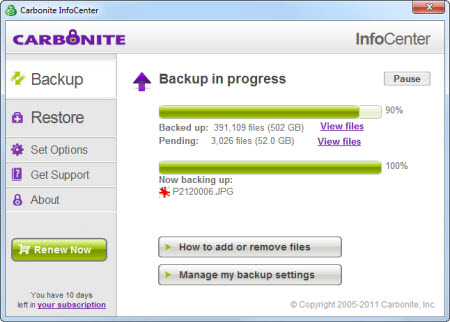 Carbonite makes the process easy. The servers in Boston stick a straw into my computer (figuratively, of course) and suck data off to a safe place whenever the computer is on. Currently Carbonite is storing nearly 400,000 files (500GB) and at the time I prepared this report it was backing up another 3000 new files. That's great but I don't even want to think about how long it would take to restore all those files. And not every file is backed up to Carbonite. I specifically exclude some files that I know aren't essential.
Carbonite makes the process easy. The servers in Boston stick a straw into my computer (figuratively, of course) and suck data off to a safe place whenever the computer is on. Currently Carbonite is storing nearly 400,000 files (500GB) and at the time I prepared this report it was backing up another 3000 new files. That's great but I don't even want to think about how long it would take to restore all those files. And not every file is backed up to Carbonite. I specifically exclude some files that I know aren't essential.- The local "hot" backup resides on 2 external USB drives and I use GoodSync to copy new and changed files to those drives. Because these drives sit beside the computer, I can't count them as true backup devices but they are handy when I need to recover a previous version of a file or if the main system has a problem and I must switch to the notebook computer.
- The "nearby" backups are stored at my office. One contains the files that are on the hot backup. Another contains an image file of the first physical drive, which contains logical drives C and F. Drive C is my Windows boot device and having an image of that drive, rather than a file backup, should make it possible to restore the computer if I ever need to.
Until recently I've used Norton Ghost for the nearby backups but recently I ran across a British product called Macrium Reflect. There's a free version, one that's primarily designed for home users, another for business users, and yet another for enterprise use. Although the free version omits some important usability features, it offers everything needed to secure your data.
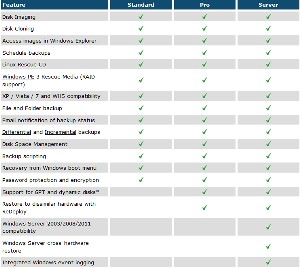 The free version (note that it is missing from the chart at the right) omits some key features—differential and incremental backup, for example—that are available in the paid versions. Macrium allows you to create an XML definition file so that you can repeat the backup at any time but if you want to repeat a backup that took 7 hours, the repeated backup will take 7 hours. This alone might be worth paying for either the standard or pro version because they can create differential and incremental backups.
The free version (note that it is missing from the chart at the right) omits some key features—differential and incremental backup, for example—that are available in the paid versions. Macrium allows you to create an XML definition file so that you can repeat the backup at any time but if you want to repeat a backup that took 7 hours, the repeated backup will take 7 hours. This alone might be worth paying for either the standard or pro version because they can create differential and incremental backups.
- Differential: Each new backup includes all the files that have been created or modified since the last full backup. Restoring requires only that you use the full backup and the most recent differential backup but this process consumes more disk space.
- Incremental: Each new backup includes only the files that have been created or modified since the last full backup or the last incremental backup. This process consumes less disk space but restoring requires that you reload the last full backup and all incremental backups.
Maybe Norton Ghost has met its match because even the free version of Macrium Reflect can clone a system drive. This is particularly useful when you need to upgrade the computer's hard drive or when you buy a new computer and want to move everything to the new machine.
Click any of the smaller images for a full-size view.
Macrium Reflect in Action
My usual process with a new application is to ignore the instructions, install the thing, and see how much damage I can cause. I do it this way because that's the way most users install software. I have to admit that I was impressed to find that it was easy to use.
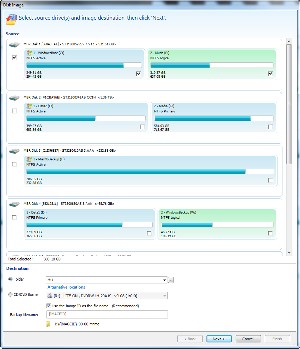 I wanted to create an image of the boot drive (C). Creating an image file requires imaging the entire physical drive. As you can see here, the physical drive contains 2 logical drives, C (which contains Windows and applications) and F (which is primarily used for music).
I wanted to create an image of the boot drive (C). Creating an image file requires imaging the entire physical drive. As you can see here, the physical drive contains 2 logical drives, C (which contains Windows and applications) and F (which is primarily used for music).
So I selected the first physical drive and deselected all of the other drives on the computer.
Then Macrium Reflect wanted to know where it should place the image. I selected drive H, which is a Western Digital USB drive that I store at the office.
This seems too easy but I clicked Next anyway.
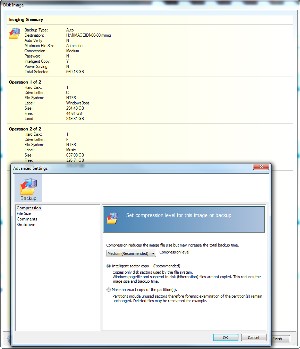 Macrium reflect said that it would use drive H for the backup and that there were two operations to perform, one for drive C and one for drive F. At the bottom of the screen there was a button for advanced options.
Macrium reflect said that it would use drive H for the backup and that there were two operations to perform, one for drive C and one for drive F. At the bottom of the screen there was a button for advanced options.
Here I had the opportunity to modify several advanced options but they all seemed to have reasonable settings so, after looking at them, I proceeded to the next step.
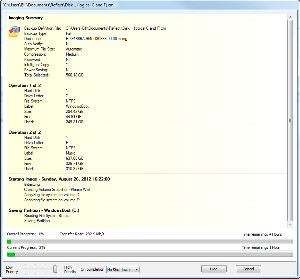 This screen reports the progress of the various operations.
This screen reports the progress of the various operations.
In this case the full image backup required several hours, even with a transfer rate higher than 280 megabytes per second. With the free version, creating a weekly image back up will always consume several hours.
Even so, if you want to stick with the free version and you store the backup drive at the office, what's wrong with bringing the backup drive home one night each week, starting the backup when you go to bed, and then taking the drive back to the office in the morning?
Macrium Pro
For drives that are so large that a full backup takes several hours, purchasing one of the paid versions makes a lot of sense. Macrium provided a review copy for my testing and when I ran an incremental backup after installing several new applications, that process consumed considerably less time. Specifically, 19 minutes 12 seconds compared to approximately 6 hours. I really wouldn't want to run a 6-hour process every week but a 20-minute process is barely noticeable, particularly when it can run in the background with only a minimal effect on system performance.

Each incremental backup is stored as a separate file. The full backup was 507 gigabytes and the incremental backup (new and changed files since the last full backup) is 3 gigabytes.
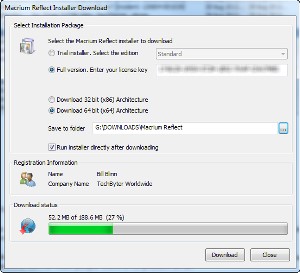 I've learned that it's possible to discern a fair amount about a software publisher's capabilities and attention to detail by watching what happens during the download and installation process.
I've learned that it's possible to discern a fair amount about a software publisher's capabilities and attention to detail by watching what happens during the download and installation process.
The installer asked for the installation key Macrium had provided. When I filled that in, it recommended downloading the 64-bit version, offered the option of running the installation immediately after download, and identified me as the license holder.
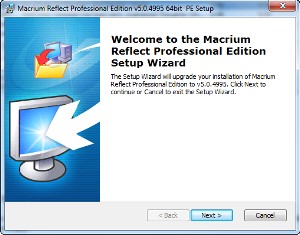 Next, as expected, the installer noticed that I already had the free version installed and said that it would upgrade that to Macrium Pro.
Next, as expected, the installer noticed that I already had the free version installed and said that it would upgrade that to Macrium Pro.
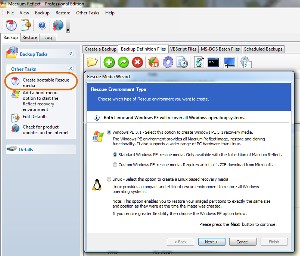 With the installation complete, I realized that I had neglected to create a recovery disc with the free version so that was my first order of business. You have two options:
With the installation complete, I realized that I had neglected to create a recovery disc with the free version so that was my first order of business. You have two options:
- Windows PE 3.1: The Windows Preinstallation Environment, a minimal Win32 operating system with limited services that is used to prepare a computer for Windows installation, to copy disk images from a network file server, and to initiate Windows Setup. Because this option allows restoration of a disk image to a drive that is not the same size as the original, it is the option most users should choose.
- Linux: Although this option is more compact than the Windows PE option, it allows restoration of an image only to identical hardware. If a disk drive fails, you would need to replace it with a drive that's exactly the same as the original and with the constant advances in disk technology, that could be difficult.
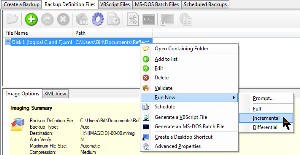 When I created the original image backup with the free version of Macrium, the process created an XML file that describes the backup. How might I create either an incremental or differential backup now that I have the professional version? There's no option on the menu that addresses anything other than full backups.
When I created the original image backup with the free version of Macrium, the process created an XML file that describes the backup. How might I create either an incremental or differential backup now that I have the professional version? There's no option on the menu that addresses anything other than full backups.
So I right-clicked the XML file that the free version had created. The Run Now menu item indicated that sub-items were present and there's where I found options to re-run the full image backup, an incremental backup, or a differential backup.
Suddenly, a Boot Menu
Later in the day that I installed the professional version and updated the system image backup, I rebooted the computer and was presented with a boot menu. The options seemed ominous:
1-Windows 7 Ultimate (recovered)
2-Macrium Reflect System Recovery
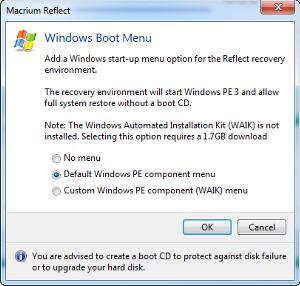 As it turns out, this is simply Macrium Reflect's way of protecting users. I had already created a recovery disc but Macrium had also installed the Windows Preinstallation Environment so that it would be possible to perform a system recovery even without the boot disc.
As it turns out, this is simply Macrium Reflect's way of protecting users. I had already created a recovery disc but Macrium had also installed the Windows Preinstallation Environment so that it would be possible to perform a system recovery even without the boot disc.
Of course this would work only if the disk drive was still fully functional and that the failure had been caused by malware or an application. If the disk drive has physical damage that prevents it from booting, the boot menu would never appear. I've decided to retain the boot menu but if it makes you uneasy or confuses other users of the computer, you can turn it off by selecting Add Recovery Boot Menu Option from the Other Tasks menu and then selecting No menu.
This is described in the menu but Macrium might want to consider creating an on-screen reminder when the boot menu is automatically created.

 Macrium Reflect Upstages the Competition
Macrium Reflect Upstages the Competition
As I said in the headline, you can't have too much backup and Macrium Reflect (at $45 for the standard version or about $60 for the professional version) is an excellent choice. If you have more than one computer in your home or office, Macrium offers 4-system packages (about $90 and $120 respectively). Although you can back up to optical discs, external USB drives are overall less expensive, far faster, and a lot more convenient.
For more information, visit the Macrium website.
Adobe Updates You Should Download
Adobe has announced release-candidate updates to several applications that you should download. The most significant update is the release candidate for Lightroom 4.2 but Adobe also has updates for Camera Raw and the DNG Converter (both version 7.2). The Lightroom update fixes some bugs that persisted in version 4.1 and the Camera Raw/DNG Converter applications add support for some new cameras in addition to squishing some bugs.
Adobe explains it this way: Lightroom 4.2 is now available as a Release Candidate on Adobe Labs. The ‘release candidate’ label indicates that this update is well tested but would benefit from additional community testing before it is distributed automatically to all of our customers. The final release of Lightroom 4.2 may have additional corrections or camera support.
If you download the release candidate, it will update the current installed version of Lightroom and, when the final code is released, it will update either the previous version of Lightroom or the release candidate, whichever is installed.
Adobe says that the release candidate fixes the following version 4.1 bugs:
- Folder stacks with virtual copies become unstacked when moving to another folder.
- Stacked photos are hidden in both the Grid view and Filmstrip. This occurs when photos become unstacked as a result of enabling auto-stacking.
- Errors encountered when publishing videos to Facebook through the Facebook Publish Service.
- Problems that occur when trying to enter the Web Module from Library.
- The inability to edit JPEG photos in Photoshop Elements
- The inability to upload files to Flickr if there is a carriage return in either the Title or Caption fields (Win only).
- Background graphics that are applied to a Book globally may not appear as expected in a saved PDF.
- Certain book covers had spine text positioned in a horizontal manner, instead of vertical.
- Double-byte characters were not exported to PDF in books
- Photos were exported with original GPS coordinates recorded by the camera instead of with the GPS coordinates updated in Lightroom.
- Keyboard shortcuts in the Develop module sometimes did not work when editing an image in Process Version PV2010.
- Parents and synonyms of “do not export” keywords also failed to export.
- Audio does not play in video files after creating a slide show containing music. (Only in Windows 7.)
- Tether support did not function properly for Nikon D4, D800, and D800E. (Only in Windows 7.)
Support is also provided for several new cameras, including Canon EOS 650D, Canon Rebel T4i, Canon EOS M, Fuji FinePix F800EXR, Leaf Credo 40, Leaf Credo 60, Panasonic DMC-FZ200, Panasonic DMC-G5, Panasonic DMC-LX7, Pentax K-30, and Sony DSC-RX100. And the Lightroom 4.2 release candidate supports the Albums functionality in the recently released Adobe Revel 1.5.
You can download the Lightroom update from Adobe Labs.
Adobe Camera Raw 7.2 and DNG Converter 7.2 release candidates are also available from Adobe Labs These releases includes bug fixes, new camera support, and new lens profiles. Camera Raw 7.2 Release Candidate includes tools to recover image sensor data typically lost when shooting in a camera crop mode. It's now possible to view the entire recorded image instead of just the crop-mode image selected in the camera. This feature does not work in Nikon or Panasonic cameras as cameras from these vendors crop the raw data to the chosen aspect ratio.
The update provides support for the same cameras listed in the Lightroom 4.2 section and also adds support for a variety of new lenses including Canon Canon EF 24mm f/2.8 IS USM, Canon Canon EF 28mm f/2.8 IS USM, Canon Canon EF 40mm f/2.8 STM, Canon Canon EF-S 18-135mm f/3.5-5.6 IS STM, Canon Sigma 18-250mm F3.5-6.3 DC Macro OS HSM, Canon Zeiss Distagon T* 2/25 ZE, Canon Zeiss Distagon T* 1,4/35 ZE, Leica LEICA APO-SUMMICRON-M 50 mm f/2 ASPH., Leica LEICA APO MACRO SUMMARIT-S 120 mm f/2.5 (CS), Leica ELMARIT-S 30 mm f/2.8 ASPH. (CS), Leica SUMMARIT-S 35 mm f/2.5 ASPH. (CS), Leica SUMMARIT-S 70 mm f/2.5 ASPH. (CS), Leica APO ELMAR-S 180 mm f/3.5 (CS), Leica VARIO-ELMAR-S 30-90 mm f/3.5-5.6 ASPH., Leica SUPER-ELMAR-S 24 mm f/3.5 ASPH, Nikon AF-S DX NIKKOR 18-300mm f/3.5-5.6G ED VR, Nikon AF-S NIKKOR 24-85mm f/3.5-4.5G ED VR, Nikon-mount Sigma 18-250mm F3.5-6.3 DC Macro OS HSM, Nikon-mount Tamron SP 24-70mm F/2.8 Di VC USD A007N, Nikon-mount Zeiss Distagon T* 2/25 ZF.2, Nikon-mount Zeiss Distagon T* 1,4/35 ZF.2, Pentax smc DA 40mm F2.8 XS, Pentax smc DA 50mm F1.8, Pentax smc DA 645 25mm F4 AL (IF) SDM AW, Pentax smc D FA 645 25mm F4 AL (IF) SDM AW, Pentax-mount Sigma 18-50mm F2.8-4.5 DC HSM, Sigma 18-250mm F3.5-6.3 DC Macro OS HSM, Sony-mount Sigma 18-50mm F2.8-4.5 DC HSM, and Sony-mount Sigma 105mm F2.8 EX DG OS HSM Macro.
Fixed bugs:
- The inability to change erase size, feather. and flow settings while utilizing the Option key.
- The inability to write meta-data to images previously opened in some 3rd party software.
- The inability to use the Luminance Noise slider when Clarity is greater than 0.
- In certain cases, the new Defringe controls caused vertical streaks to appear.
- Some images from Canon 5D Mark II exhibited pattern noise in the form of maze/green split artifacts.
- Adjusting the blue channel did not affect monochrome images.
- Certain TIFF files can cause Bridge to become unstable.
- Defringe settings were not retained when editing the file in Photoshop as a Smart Object and then returning to Adobe Camera Raw.
Adobe notes that some bugs remain to be fixed in the next version:
- A high number of artifacts exist in Adobe Camera Raw text fields in the Panel but only in Apple OS X 10.8 (Mountain Lion).
- The File-Quit menu item is greyed out in the DNG Converter but the keyboard shortcut (Command+Q) operates as expected. This occurs only on the Mac platform.
You can download the Adobe Camera Raw and DNG Converter updates from Adobe Labs. Note that a reboot is required on Windows systems after installing the Adobe Camera Raw release candidate.
A New Photoshop Touch, Too
Adobe has also updated Photoshop Touch, an application for Ipad and Android tablets, to version 1.3. Photoshop Touch places basic Photoshop features on tablets and gives users the ability to create layered images, make edits to their images, and apply certain effects. The resulting images may be shared through Facebook or automatically synced through the Adobe Creative Cloud and and then refined in Photoshop CS6.
Adobe's Stephen Nielson says that Photoshop Touch can now work with print-resolution images, up to 12 megapixels with up to 16 layers. Note that the application's default resolution is 4.2 megapixels with 10 layers, but that can be increased in Preferences.
The upgrade is free to current users or $10 for new users and is available via the Apple Apps Store and Google Play.
Short Circuits
Picture This: Facebook's Stock Finally Begins to Rise
Like a loaf of bread dough in a warm room, Facebook's stock has finally begun to rise, slowly. It was up about 5% this week after the huge drop immediately after Facebook's IPO. One reason for the increase is the company's reassuring words to investors to let them know that some major stockholders will hold on to their shares even though they could now sell them and also that Facebook will buy back nearly $2 billion worth of shares.
CEO Mark Zuckerberg announced that he has no plans to sell shares other than those needed to take care of substantial tax obligations. The statement was made in a filing with the Securities and Exchange Commission. Additionally board members Marc Andreessen and Donald Graham say they're on board for the long term.
Facebook will spend nearly $2 billion to buy back 101 million shares from early employees and made certain other changes that will make about 234 million shares of stock available for sale around the end of October instead of the middle of November but the overall total number of insider shares that will be available will be reduced by about one third.
When the first lockup period expired in August, Facebook's share price continued to fall. The value dropped 53% from the IPO in May.
But this week the Facebook acquisition of Instagram finally concluded. The Federal Trade Commission began investigating the acquisition in April and finally approved the deal in August.
Instagram attempted to calm worried users by stating on its blog that the photo app will be changing little, if at all. "The Instagram app and its features will stay the same one you know and love, and we’ll keep working together to build a better Instagram for everyone."
Initially the cash-and-stock deal would have been worth $1 billion to Instagram but by the time the deal closed, Facebook's falling stock prices reduced the valuation of the deal to a paltry $715 million.
Facebook's Vice President of Engineering Mike Schroepfer wrote on the Facebook blog "Instagram will continue to serve its community, and we will help Instagram continue to grow by using Facebook’s strong engineering team and infrastructure." In other words, Facebook has no plans to consume the technology and then discontinue Instagram as a separate service.
Late to Acknowledge the Internet, Microsoft Will Not Miss the Cloud
In the 1990s, Microsoft largely wrote off networking and the world's largest network, the Internet. The company was late to acknowledge that people might want to network their home computers and was late to market with a badly flawed browser that even now, 17 years after IE version 1, is still an also-ran in terms of technology but nonetheless the market leader among users.
Later this year Windows 8 will be released and it is built to work seamlessly with cloud-based applications and cloud-based storage. The new server version of Windows, Windows Server 2012, will work as servers always have down here on the ground in computer rooms but it will also be able to connect with about 200 remote services that are part of Microsoft's Azure system.
Clearly Microsoft has realized both the potential and the threat presented by housing software and applications on the Internet.
Developers see a future where desktop computers with installed applications will be less important than they are today. Microsoft already has big server-based offerings such as SharePoint and Exchange. Both of these are already big moneymakers for Microsoft but the company sees change coming. Change that will mean lower sales of applications such as the Office suite, sold on optical discs and installed on individual computers. Microsoft, along with other large software companies such as Adobe, are betting on the "software as a service" business model.
Adobe already offers its Creative Suite CS6 as a service (from about $20 to $50 per month, depending on which applications you need) and the Microsoft's Office 2013, now available as a consumer preview, stores documents online by default.
The term "in the cloud" still seems every bit as silly as "desktop publishing" did in the 1980s but the trend is clear. Stand back. The future is knocking.
Oracle Owes Google $1 Million in Chump Change
To me and probably to you, $1,000,000 is nothing to sneeze at. Even the Barenaked Ladies (none of whom are either naked or ladies) sang about that sum. If you're old enough, you might remember a TV show in which the fictitious John Beresford Tipton, Jr., had Michael Anthony hand people checks for $1,000,000. In 1955, it was a lot of money. But today to companies such as Oracle and Google, it's a rounding error in the bookkeeping system. If either company dropped $1,000,000, it wouldn't even bother to lean over and pick it up. (The Supreme Court says that corporations are people so I don't feel at all odd thinking about a company bending over to pick up $1,000,000.)
But to wander back on track, the point of this rambling account is that Oracle will have to pay $1,000,000 worth of court costs for Google. US Judge William Alsup made that ruling this week. Oracle must reimburse what Google paid to a court-appointed expert during the intellectual property suit over Google’s Android software. Alsup, however, refused to order Oracle to scrape up a little more pocket lint and pay Google an extra $3 million for discovery fees.
Oracle is appealing the ruling and that will probably cost many times the court-ordered judgment. Such is the US legal system.
Amazon is Fired Up and Ready to Go
The new Kindle Fire has a larger screen (although not as large as an Ipad), faster Wi-Fi (two connections are better than one), and a price tag that's considerably lower than that of Apple's Ipad. Apple is clearly the market leader and Amazon is hoping to change that.
The original Fire had a 7-inch screen. The new screens are a little over 8½ inches (measured diagonally, of course). This compares with a bit under 10 inches for the Ipad. Apple's mini Ipad could be announced next week and it's expected to have a sub-8-inch screen.
Amazon will also soon release the Kindle Fire HD (HD indicating "high definition") and it will have 2 Wi-Fi channels. The extra channel will make data transfer faster and Amazon hopes buyers will use it to view Amazon's streaming movies. The HD will have 16GB of storage built in, which is the same as the Ipad.
Yet another model can connect to 4G cellular networks. It comes with 32GB of memory and a screen that's nearly 9 inches across. This model will cost $500 and requires an annual data plan that will sell for $50.
And the old Kindle isn't dead but now it's called "Paperwhite". Amazon CEO Jeff Bezos says "the whites are whiter, and the blacks are blacker." Unlike the old Kindle, the Paperwhite also has a light source. The price will be $120.



 The author's image: It's that photo over at the right. This explains why TechByter Worldwide was never on television, doesn't it?
The author's image: It's that photo over at the right. This explains why TechByter Worldwide was never on television, doesn't it?
